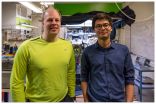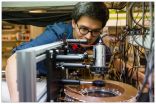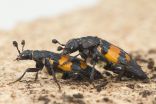INFORMATION:
Article: http://journals.aps.org/prl/abstract/10.1103/PhysRevLett.114.093002
Video: Ultra-precise Atomic Clocks: http://www.nbi.ku.dk/english/sciencexplorer/atomic_physics/jan_thomsen_atomure/video/
Contact:
Jan W. Thomsen, associate professor and head of the research group, Ultra Cold Atoms at the Niels Bohr Institute at the University of Copenhagen, +45 5168-0410, jwt@fys.ku.dk
Bjarke Takashi R&ostroke;jle Christensen, PhD student, Ultra Cold Atoms at the Niels Bohr Institute at the University of Copenhagen, +45 2682-9051, bjarkesan@nbi.ku.dk
Quantum mechanic frequency filter for atomic clocks
2015-03-09
(Press-News.org) Atomic clocks are the most accurate clocks in the world. In an atomic clock, electrons jumping from one orbit to another decides the clock's frequency. To get the electrons to jump, researchers shine light on the atoms using stabilised laser light. However, the laser light has to have a very precise frequency to trigger very precise electron jumps. It is however challenging to get the laser light frequency ultra precise - there will always be a little 'noise'. Now researchers from the Niels Bohr Institute have developed a method that reduces the noise so that it is up to 100 times quieter. The results are published in the scientific journal Physical Review Letters.
The atoms in the atomic clock are made up of strontium gas, kept in a vacuum chamber. Using magnetic fields and precise beams of laser light (blue light), the atoms are cooled down to near absolute zero, minus 273 degrees Celsius, where it is maintained.
The electrons are located in certain orbits around the nucleus and each orbit has one energy level. By now flashing the strontium atoms with laser light (red light), the electrons get a higher energy level and jump from one orbit to the next, but they immediately jump right back to their normal orbit. When you then shine the light on the strontium atoms, the electrons keep jumping back and forth in a classical sense and this constitutes the pendulum in the atomic clock.
An atomic clock is now so precise that it only loses one second every 300 million years, but we are working to make it even more precise and this has great potential, including for navigation and space based optical technology for exploration of the universe. The problem with making it more precise is controlling the laser light, so that the light has exactly the wavelength that hits the atoms' electrons and gets them to oscillate very precisely and very accurately.
Solves noise problems
"The laser light is stabilised, but it fluctuates a bit and creates 'noise'. Since there are several wavelengths at the same time due to the noise, we send the light via a mirror to a 'resonator', which is two mirrors joined together so that it allows some waves to pass, while the rest disappear. So it is a sorting mechanism so that the laser light wavelengths become more precise. So, everyone should be happy, but the mirrors fluctuate slightly - simply because the atoms in the mirror vibrate and this puts some limitations on the stability that we could not get rid of. So we said - why don't we try to change our mindset and turn the whole thing upside down," explains Jan Thomsen, associate professor and head of the research group, Ultra Cold Atoms at the Niels Bohr Institute at the University of Copenhagen.
And so they did - turned it all upside down. Instead of trying to further stabilise the mirrors, they decided to completely ignore the vibrations. They decided to put 'something' between the laser light and the resonator's two mirrors. This 'something' would act as a filter.
The filter consisted of a vacuum chamber with ultra cold strontium atoms between the two mirrors. Strontium is a very 'demanding' atom, which must have a very specific wavelength in order to react with the light. The light is now sent back and forth between the two mirrors and even though the two mirrors vibrate a little due to the temperature in the room, the light does not care, because it is primarily the cold atoms that sort the wavelengths.
"The method is simple, but effective and the result is that the laser beam is much more precise and stable and the noise is reduced by up to 100 times. So we have developed a technique that can create an ultra-precise laser beam using a quantum frequency filter," explains Jan Thomsen, who points out that the technique could be used to make atomic clocks more precise than until now and in a much simpler way than before.
ELSE PRESS RELEASES FROM THIS DATE:
Ledipasvir plus sofosbuvir: Hint of added benefit in certain patients
2015-03-09
The drug combination of ledipasvir and sofosbuvir (trade name Harvoni) has been available since November 2014 for the treatment of chronic hepatitis C infection. The German Institute for Quality and Efficiency in Health Care (IQWiG) examined in a dossier assessment whether this new drug offers an added benefit over the appropriate comparator therapy.
IQWiG found a hint a non-quantifiable added benefit for two out of seven patient groups in total: in an infection with genotype 1 hepatitis C virus (HCV) when previous therapies had been unsuccessful, and when previously ...
Cancer-linked protein helps control fate of intestinal stem cells
2015-03-09
HEIDELBERG, 10 March 2015 - An international group of researchers has shown that a regulatory protein involved in controlling how cancer spreads through the body also influences the fate of stem cells in the intestine of mice. The results, which are published in The EMBO Journal, show that the Snai1 protein plays an important role in deciding the fate of intestinal stem cells and the different functions that these cells can adopt.
"Our results show that Snai1 is a key regulator of crypt base columnar cells, a type of stem cell found in the invaginations or crypts that ...
Research explores patient views of GP safety
2015-03-09
New research conducted by The University of Manchester has found that GPs' patients can feel alienated by lack of trust, impersonal processes and that this presents problems to improving their safety.
Most research into patient safety focuses on the systems operated by health services. This is particularly focused on hospitals. However, most encounters occur within GP services where relationships between doctor and patient can form a significant part of reaching successful diagnosis and treatment.
The team from the NIHR Greater Manchester Primary Care Patient Safety ...
Millions of modern men found to be descendants of 11 Asian dynastic leaders
2015-03-09
Study suggests that millions of modern Asian men are descended from 11 ancient leaders, including Genghis Khan
Sample examined the Y chromosomes of 5,000 Asian men from 127 populations
Historical nomadic and mobile populations allowed for Y chromosomes to be spread far and wide
Geneticists from the University of Leicester have discovered that millions of modern Asian men are descended from 11 powerful dynastic leaders who lived up to 4,000 years ago - including Mongolian warlord Genghis Khan.
The study, which is funded by the Wellcome Trust and published in ...
Love, love me do: Male beetles that have more sex are more insecure, study shows
2015-03-09
Males that mate more often are more insecure about their social status than those mating less, according to new research on the behaviour of burying beetles.
The study, published in the journal Evolution, provides new evidence that the social sensitivity of male behaviour is linked to how often male beetles mate.
Male burying beetles actively compete with each other for access to breeding resources such as dead mice, and when they find a suitable carcass will emit pheromones as a signal to attract females. But the emission of pheromones may also attract other males, ...
Who am I? New study links early family experiences, self-esteem with self-clarity
2015-03-09
BUFFALO, N.Y. - Although some children emerge from cold and neglectful family environments as adults with high self-esteem, a new University at Buffalo study suggests these people may still be at a relative disadvantage in life, with a foggier sense of who they are.
On the other hand, adults with low self-esteem who grew up in the same type of negative environment actually have relatively high self-clarity, according to the study's findings.
"Our findings show that even those people who manage to get out of that relatively negative time and view themselves as good, worthwhile ...
Bioengineers put human hearts on a chip to aid drug screening
2015-03-09
Berkeley -- When University of California, Berkeley, bioengineers say they are holding their hearts in the palms of their hands, they are not talking about emotional vulnerability.
Instead, the research team led by bioengineering professor Kevin Healy is presenting a network of pulsating cardiac muscle cells housed in an inch-long silicone device that effectively models human heart tissue, and they have demonstrated the viability of this system as a drug-screening tool by testing it with cardiovascular medications.
This organ-on-a-chip, reported in a study to be published ...
Measuring the marketing effectiveness of asking versus telling
2015-03-09
Chestnut Hill, MA (March 9th, 2015): From "Got Milk?" to "What's in your wallet?" to "Are you a Mac or a PC?" promotional phrases consisting of a simple question have proven to be quite effective, but are they more effective than a simple statement? That depends. Henrik Hagtvedt, Ph.D., a Marketing professor at the Carroll School of Management at Boston College, has just finished investigating what happens when you replace a period with a question mark, or vice versa, and how that affects whether a consumer makes a purchase.
"I've long been interested in ambiguity and ...
Physical labor, hypertension and multiple meds may reduce male fertility
2015-03-09
This news release is available in Spanish. Working in a physically demanding job, having high blood pressure, and taking multiple medications are among health risks that may undermine a man's fertility, according to a study by researchers at the National Institutes of Health and Stanford University, Stanford, California. The study is the first to examine the relationships between workplace exertion, health, and semen quality as men are trying to conceive. The results were published online in Fertility and Sterility.
"Nearly 15 percent of U.S. couples do not become ...
Breast cancer risk may be increased in women who have first-degree relatives with a history of prostate cancer
2015-03-09
Having a family history of prostate cancer among first-degree relatives may increase a woman's risk of developing breast cancer. That is the conclusion of a new study published early online in CANCER, a peer-reviewed journal of the American Cancer Society. The study's results indicate that clinicians should take a complete family history of all cancers--even those in family members of the opposite sex--to help assess a patient's risk of developing cancer.
Evidence suggests that the risk of developing breast and prostate cancer is increased among individuals with a family ...




